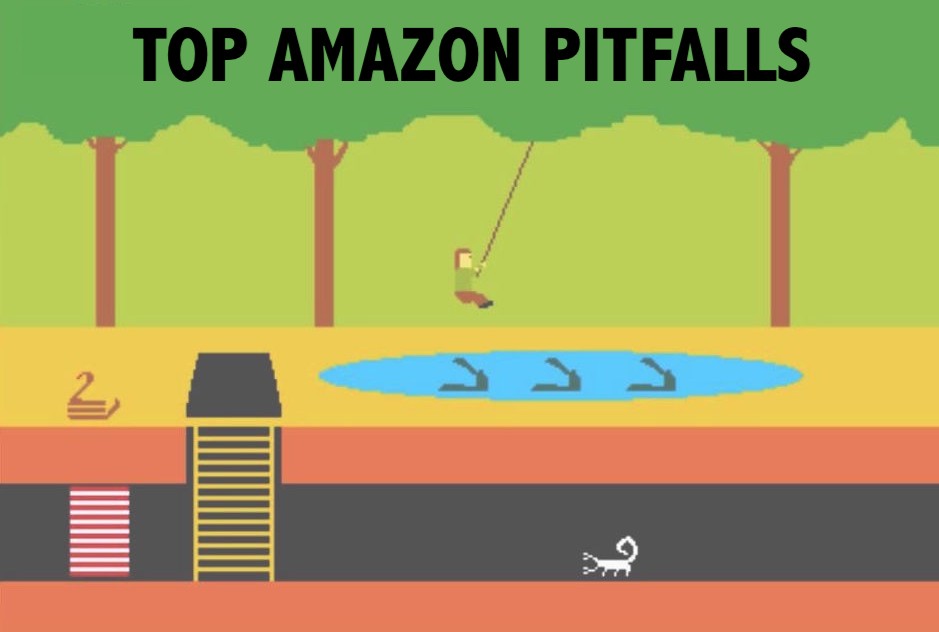It’s easy to make mistakes when you’re starting out, so we’ve compiled a list of seven common FBA beginner pitfalls to help you learn and succeed from the get-go! In this episode, you’ll find out why it’s essential not only to learn but to act, how to check your approval status for items you’re sourcing, and how to approach negative feedback. We share an overview of Amazon’s feedback guidelines and tips for tracking your numbers.
Listen today to find out what you are and aren’t allowed to request from your customers, as well as why ignoring them is never an option. By avoiding these seven pitfalls, you’ll be well on your way to turning part-time hours into a full-time income reselling on Amazon.
Listen on the podcast player below.
Like what you hear? Tell a friend… and be sure to leave us a rating and a review. Here’s how.
Key points from Episode 173:
 The danger of learning too much vs not taking enough action.
The danger of learning too much vs not taking enough action.- How to check if you’re approved to sell items before sourcing them.
- How to approach negative feedback.
- An overview of Amazon’s feedback guidelines.
- Why you should never ignore your customers.
- Why it’s important to track your numbers and how to do so.
- How to keep track of Amazon’s guidelines (and why it’s essential that you do!).
Links and resources mentioned in this episode:
- RevSeller
- InventoryLab
- How To Handle Negative Feedback
- Amazon Feedback Guidelines
- Amazon Guidelines
- Jumpstart Your FBA Business
Right-click here and save as to download this episode to your computer.
![]()
 JumpStart Amazon
JumpStart Amazon
Build a Successful Amazon FBA Business
By now you know that running a successful Amazon business takes hard work, but you also want to be sure you spend your time focusing on Amazon FBA strategies that are actually proven to provide the results you’re looking for. If you’re ready to finally get serious about your Amazon FBA business, then I invite you to check out JumpStart Amazon: Build a Successful Amazon FBA Business.
JumpStart Amazon is a combination video course and ebook. The ebook is over 220 pages filled with the content and graphics you need to start a successful Amazon business from scratch. The video course features 5 main sections, 19 content-packed modules, and over 40 videos adding up to over 10 and a half hours of video training. This training is set up to help you build a solid foundation and then know how to find growth and success on top of the basics. This course is packed with more results-focused knowledge than any other ebook out there centered around starting an Amazon business. Find out more about JumpStart Amazon today.
Back to the main page for The Full-Time FBA Show
More Episodes from the Full-Time FBA Show podcast:
Don’t miss an upcoming episode! Subscribe, download episodes, and review the Full-Time FBA Show:
-
-
- Subscribe on iTunes
- Follow on Spotify
- Follow on Amazon Music (or just ask Alexa to “play The Full-Time FBA Show podcast”)
- Follow on iHeartRadio
- Subscribe on Podbean
- Subscribe on Podbay
- Subscribe on Podchaser
-
![]()
Episode 173 Transcript:

[INTRODUCTION]
[0:00:01.8] ANNOUNCER: Welcome to The Full-Time FBA Show. In each episode, it’s our goal to help you turn part-time hours into a full-time income, selling almost anything on Amazon. Now, your hosts of the show, Stephen and Rebecca Smotherman.
[WELCOME]
[0:00:21.4] STEPHEN: Welcome to episode number 173 of the Full-Time FBA Show. Today, we’re talking about seven beginner pitfalls to Amazon FBA success and to talk about these pitfalls is my wife, how are you doing Rebecca?
[0:00:34.5] REBECCA: I’m good. Every time you say beginner pitfalls, I think of that old Atari game, Pitfall.
[0:00:39.1] STEPHEN: Oh yeah, with the little Tarzan guy going… I listened to the 80s on eight on series XM and they play that audio clip over and over again and I just love it. I don’t know.
[0:00:49.3] REBECCA: Well, there you go, that should be like our little theme for this episode is the Pitfall music.
[0:00:54.7] STEPHEN: Yeah, can we legally put that on over our podcast? I don’t think we could, I don’t know but that’s what we’re going to talk about, beginner pitfalls so you don’t fall in and die, all right? Okay, so death is not really an actual consequence of these pitfalls but losing your Amazon account or getting suspended might be. So let’s stop teasing this and get right into the episode.
[DISCUSSION]
[0:01:14.9] REBECCA: Before we get started, we want to remind you that if you haven’t already, you need to sign up for The Full-Time FBA newsletter.
[0:01:21.6] STEPHEN: Yes, it’s a need. I mean, there’s water, there’s clothing, there’s shelter, there’s all those things, and The Full-Time FBA newsletter.
[0:01:28.8] REBECCA: Right, yeah. It’s that kind of need, it’s on that level. Anyway, back to what I was saying, if you go to fulltimefba.com you can sign up for the newsletter, we send out an email once or twice a week with articles, links to podcast episodes from the past or upcoming videos, things of that nature that will help you with your FBA business. So be sure you’re subscribed at fulltimefba.com.
So getting into our topic for today, seven beginner pitfalls to Amazon FBA success, it seems that a lot of Amazon sellers when they’re beginning their Amazon business, they face very similar pitfalls or difficulties. There are some things that just really we all have in common as we’re getting started selling on Amazon. So today, we’re going to discuss some of those, of the most common rookie mistakes that we face when we’re getting started as FBA sellers.
[0:02:18.4] STEPHEN: Yeah and some of these mistakes you might have started making when you first started and you might still be making them even after you’re selling on Amazon for a little bit of time. So it’s good for even experienced Amazon sellers to double check, do a little self-check on your Amazon business to see if these still are impacting your Amazon business negatively and the first one we even had a whole episode on last week episode 172, about learning too much and not taking enough action.
Yeah, this was so big, we had a whole episode on this and it was all focused on the fact that we loved to learn and learning is easy and learning is safe but taking action is kind of scary. There is fear involved that we have to come over and a beginner mistake is that they get too stuck in learning things from courses or watching YouTube videos about how to sell on Amazon or getting on social media and learning other stuff that they’re not actually putting into action what they are learning.
So a quick reminder, as a beginner and as an experienced seller, learn and act. Learn and act, don’t learn and learn and learn and learn and learn with no action. You don’t want to atrophy, you want to have some really good growth in your Amazon business, continue to put things into action that you learn.
[0:03:28.2] REBECCA: The second pitfall that we want to make sure that you have been warned about is that it can be easy to develop a habit as an Amazon seller, especially in the beginning when you’re still developing those habits, of not checking items to see if you’re approved to sell them before you source them.
This is one that really is a habit that you have to work on and you have to build it. You need to be checking before you click purchase or before you walk out of the store with that receipt in hand and those items in your cart that you can actually sell that item on Amazon and there are some really quick and easy ways to do this, whether you are sitting at your laptop, sourcing online or doing any wholesale sourcing or whether you’re in a store doing retail arbitrage.
If you’re on your laptop, we recommend using the RevSeller app for all sorts of data that pertains to an Amazon product listing and it has a really handy little button on the Chrome extension that allows you to check whether or not you are approved to sell that item and if you are in a store sourcing, we use the Scoutify app that’s bundled with InventoryLab and they also have a button right there on their app that will allow you to check whether or not you are approved to sell an item.
So make sure that you are not restricted on every single item, especially as you’re getting started. You do not want to get stuck with inventory that you are not able to sell on Amazon because of those restrictions.
[0:04:58.1] STEPHEN: Yeah, that’s the worst, getting excited about inventory that you just purchased to sell. You get home, you’re putting together a shipment and Amazon says, you’re not approved to sell this item or worse, they let you send it in, and then they tell you that you’re not approved to sell this item. It’s going into a stranded inventory and you got to spend money to get a return and then you got to find another solution, maybe take it back to the store, oh, that’s just the worst. We want to help you avoid that. So double-check that you’re approved to sell those items that you’re sourcing.
The third pitfall we’re going to talk about getting around or going over is the fact that a lot of new Amazon sellers just ignore negative feedback. You know, they want to get positive feedback, but when they get negative feedback, they realize or think, “You know, there’s nothing I can do about it” but there actually is. I mean, sometimes the negative feedback that the customer I give you violates Amazon’s feedback rules and so you can actually ask for Amazon to remove it.
Other times, you can actually reach out to the customer to try to find or fix the solution that they’re not happy about and they might be able to update their feedback for you and you can go through that process. So you don’t ever ignore the Amazon negative feedback from customers, you want to make sure you’re going through the right steps. We’ll put some notes in the show notes, we’ll put some links in the show notes, walking you through the right ways to take care of this but definitely, do not ignore negative feedback.
[0:06:16.9] REBECCA: And on the flip side of that, the fourth beginner pitfall that we want to talk about today is asking for positive feedback. This is against Amazon’s guidelines and you really need to be familiar with the guidelines, really all of Amazon’s guidelines as you’re selling but you want to be sure, especially to check out the feedback guidelines that Amazon has in place. You can find that at a quick link, fulltimefba.com/feedbackguidelines.
So you can ask for a review but you cannot suggest a positive review and this is going to be different from what you might be used to if you’ve used other platforms for either selling or offering your services. On other platforms, you can say “Hey, if you liked what I provided, could you give me a five-star review?” You cannot do that on Amazon, you cannot ask for a five-star feedback as a seller or on your product.
So be sure that you are aware of those guidelines and that you are in compliance because that could get you in a lot of trouble if you are not following the rules.
[0:07:15.4] STEPHEN: Number five, when it comes to beginner pitfalls to Amazon FBA success is ignoring your customers. Now, when it comes to running an Amazon business, we’re all online and you know, there’s not like a customer that walks into the store that you are ignoring and you know, being rude to but a lot of times, customers reach out multiple ways to ask a question or to have a problem being fixed.
Maybe they’re sending a message to you, through the buyer communication system and if you are ignoring your customers, that is showing Amazon that you are not giving great customer service and if your customer service metrics get dinged and if it goes low enough, you’ll start losing time in the buy box and you lose time in the buy box, you’re going to start losing sales.
So you always want to make sure, never ignore your customers. You know, if they ask a question, do your best to answer it and respond quickly. Amazon likes you to reply within 48 hours usually, I try to reply as soon as possible. If I see in my email or if I see, I have a notification on my phone through the Amazon seller app that I have a customer question, I try to open it up and reply as soon as possible.
If someone just says, “Thank you so much for getting this to me. It arrived safely” and you’re like, “Okay, I don’t need to reply to that.” No, Amazon still wants you to reply or there is an option to click, “No response needed” so Amazon at least knows that you saw it and acknowledged it and there was no response needed. Always do your best to go above and beyond to take care of your customers.
Amazon wants to be the most customer-centric website on the planet, they’ve done a really good job with that and so that’s why it’s important for us to do the same thing. Let’s be customer-centric and do the best that we can to make our customers happy, within reason, obviously but don’t ignore your customers. That’s a huge beginner pitfall.
[0:08:57.2] REBECCA: The number six pitfall that we’re going to cover today is not tracking your numbers in your business. Now, the numbers that we’re referring to here are anything to do with money related to your business. We’re talking about your sales, we’re talking about your expenses, we’re talking about all of the things that go into finding out whether or not you’re actually making money or losing money as an Amazon seller.
So we have quoted this in multiple of our courses and on the podcast episodes but if you don’t know your numbers, you don’t know what’s going on in your business. So you need to know your numbers. We track all of our expenses in sales and all of that good stuff in InventoryLab. It’s a really great way to keep track, they automate a lot of the process, especially works really well with seller central, and then also, it sinks really well with our repricer and it’s a good way to enter in one spot, our buy cost for items and then it keeps track of our ROI.
It can help us to find out over time, what our history is on certain items, we can enter it in other expenses as well not just the buy cost of items as we were listing those items for sale on Amazon. Bottom line is, you need to know what’s coming into and going out of your business, in and out of your bank account and so make sure that you’re doing that on a regular basis. If you are waiting to do that once a year when it’s tax time, I mean, I know we’ve all been there before where we put it off and put it off.
I mean, who really likes keeping track of these things and looking at receipts and all of that? It’s not fun. Well, there’s probably some accountants out there who think it is fun and more power to you but most of us probably don’t enjoy that. But if you’re serious about your business and really truly want to be successful at Amazon FBA, you need to keep track of that on a regular basis and not procrastinate.
Because if you do procrastinate doing that, and aren’t keeping track of it, you’re possibly losing money that you could potentially prevent that from happening going forward, and if you just keep procrastinating, you don’t know what’s going on and you can waste months of a really easy fix on something. So be sure that you are keeping track of your numbers, don’t put it off, and avoid that pitfall.
[0:11:14.5] STEPHEN: Yeah, that’s why I love the fact that we track all of this in InventoryLab because we can run reports that can show us within a few clicks, you know, what categories are profitable or what suppliers are profitable or even if we have it set out correctly, which of our employees who are sourcing for us, which ones are profitable and all of that. We just love tracking all of this and yeah, don’t be caught up at the end of the year.
You know, especially as a beginner trying to catch up on all this, start tracking now. If you have not started yet before, start tracking now as soon as possible. So the last beginner pitfall that we’re going to talk about in this episode is pitfall number seven, ignoring Amazon’s guidelines. So we talked before about making sure you understood the feedback guidelines, well guess what? You need to make sure you are aware of all of Amazon guidelines.
We’ll put a link in the show notes, fulltimefba.com/guidelines. You need to go through and read it and read it from time to time from the updates, so that you are aware of what Amazon’s rules are, what their expectations are, what you need to follow through with, things that you need to prioritize. Amazon’s guidelines, if you start to break them, again, your metrics will be going down, you’ll get less of the buy box.
Eventually, you’ll get your account suspended or potential ASINs or category suspended, where you’re not able to even sell any of those items and so you want to be able to be sure to sell as many items as possible, so you know, make sure that you’re following Amazon’s guidelines so that you don’t miss out on all those opportunities.
So follow Amazon’s guidelines, go make Amazon happy and Amazon will in turn, make you happy with more time in the buy box because they’re like, “Oh, this seller gets it, they understand the guidelines, they’re following through, we’re going to reward them with more customers who are buying.”
So those are the seven beginner pitfalls to Amazon FBA success. For both beginners and experienced sellers who might still be experiencing these pitfalls, hopefully you know now either how to get around it, how to go around it, how to avoid it or at least know the ones you need to start trying to prioritize to fix those pitfalls so that you can see more success a lot faster than you were in the past.
So that’s it with this episode for today, if you are interested in growing an Amazon business, we suggest you go to check out fulltmefba.com/jumpstart. This is going to help you grow your Amazon business the right way from the foundation up and go check that out, fulltimefba.com/jumpstart.
[CLOSING CONVERSATION]
[0:13:33.6] REBECCA: Thank you so much for joining us for another episode of The Full-Time FBA Show. As a reminder, we have the show notes and transcript for this podcast as always, available for you at fulltimefba.com/173 because this is episode number 173. Any of the links that were mentioned and there were quite a few in this episode will be found in those show notes, fulltimefba.com/173.
[0:13:57.3] STEPHEN: And next week on the show, guess what? We got more for you, seven more beginner pitfalls to Amazon FBA success. Again, it might affect beginners and I might also be still affecting experienced sellers so be sure to listen next week on The Full-Time FBA Show.
[OUTRO]
[0:14:14.2] ANNOUNCER: That is all for this episode of The Full-Time FBA Show. So head over to fulltimefba.com/podcast, where you will find the show notes and links from this episode. While you’re there, subscribe to our newsletter where you’ll get several free downloads of our popular and helpful Amazon FBA resources. Now, take action on what you have learned today, so you can find success at turning part-time hours into a full-time income with Amazon FBA.
[END]


Thanks for sharing. I read many of your blog posts, cool, your blog is very good.